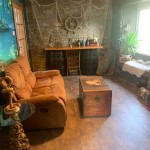How To Decorate a Small Bedroom With a Queen Bed
A queen-size bed offers undeniable comfort but can pose a decorating challenge in a small bedroom. Careful planning and strategic design choices are crucial to maximizing space and creating a comfortable, stylish sanctuary. This article outlines practical strategies to achieve this balance.
Maximize Vertical Space: In a small bedroom, utilizing vertical space is paramount. Tall bookshelves, narrow wardrobes, and wall-mounted shelves draw the eye upwards, creating the illusion of height and providing valuable storage. Consider floating shelves above the nightstands to keep essentials within easy reach without cluttering the limited surface area.
Embrace Minimalism: A minimalist approach can significantly enhance the sense of space in a small room. Opt for a limited color palette, preferably light and airy hues that reflect light, making the room appear larger. Avoid excessive decorative items and choose furniture with clean lines and simple designs. This uncluttered aesthetic promotes a sense of calm and spaciousness.
Strategic Furniture Placement: The placement of the queen bed significantly impacts the flow and perceived space of the room. Positioning the bed against the largest wall, ideally centered, often creates a balanced layout. Avoid overcrowding the room with unnecessary furniture. A small nightstand on each side of the bed might be sufficient. If additional storage is required, consider integrating under-bed storage solutions.
Optimize Lighting: Proper lighting plays a vital role in enhancing the perception of space. Natural light should be maximized by keeping window treatments minimal – sheer curtains or blinds are ideal. Layered lighting, combining ambient, task, and accent lighting, creates depth and visual interest. A ceiling fixture provides overall illumination, while bedside lamps offer focused light for reading. Wall sconces can free up valuable nightstand space.
Mirror, Mirror: Mirrors are a classic design trick for creating the illusion of more space. A large mirror placed strategically on a wall can effectively double the perceived size of the room. Consider a full-length mirror leaning against a wall or a mirrored wardrobe door to maximize this effect. The reflective surface also helps to bounce light around the room, enhancing brightness.
Multi-Functional Furniture: In a space-conscious environment, furniture that serves multiple purposes is invaluable. A storage ottoman can function as a footstool, extra seating, and a discreet storage compartment. A bed frame with built-in drawers offers convenient storage for linens and clothing. Choosing furniture with built-in functionality helps to minimize clutter and maximize every square inch.
Color Palette Considerations: Light and neutral colors are generally recommended for small bedrooms as they reflect light and create an airy feel. White, cream, beige, and light pastels are excellent choices for walls and larger furniture pieces. Accent colors can be introduced through textiles, artwork, and accessories to add personality and visual interest without overwhelming the space.
Textiles and Soft Furnishings: Choose bedding and curtains in light, breathable fabrics. Avoid heavy drapes and overly patterned textiles, which can make the room feel cramped. Opt for simple patterns or solid colors that complement the overall color scheme. A textured rug can add warmth and define the sleeping area without visually shrinking the room.
Headboard Selection: The headboard can be a focal point in a small bedroom. However, a bulky headboard can overwhelm the space. Consider a slim headboard design, such as a metal frame or upholstered headboard without a thick frame. A headboard that extends no wider than the bed frame helps to maintain a sense of openness.
Decluttering and Organization: Maintaining a clutter-free environment is essential in a small bedroom. Regularly declutter and organize belongings, utilizing storage solutions effectively. Keep surfaces clear of unnecessary items to maximize the feeling of spaciousness and promote a sense of calm.
Personalized Touches: While minimalism is recommended, incorporating personal touches adds character and warmth. A few carefully chosen artwork pieces, family photos, or decorative objects can personalize the space without overcrowding it. These personal touches make the room feel inviting and reflect individual style.
Window Treatment Strategies: Maximize natural light by opting for light-filtering window treatments. Sheer curtains or blinds allow light to enter while providing privacy. Avoid heavy drapes, which can make the room feel smaller and darker. Hang curtains from ceiling to floor to create an illusion of height.
Floor Space Management: Maintaining clear pathways and maximizing floor space is essential in a small bedroom. Avoid placing furniture too close together, which can impede movement and make the room feel cramped. A strategically placed rug can define the sleeping area and anchor the furniture without overwhelming the space.
Nightstand Alternatives: In extremely tight spaces, traditional nightstands might be impractical. Consider wall-mounted shelves or small floating nightstands to save valuable floor space. These alternatives provide a surface for essentials like lamps and books without taking up precious floor area.

20 Smart Ideas How To Make Small Bedroom Look Bigger

30 Tiny Yet Beautiful Bedrooms

Stressed Out Over A Queen Bed In 10 X Bedroom Here S 8 To Help Michael Helwig Interiors

Queen Size Bed Dimensions Amp Layout Ideas For A Small Bedroom

Cute How To Decorate Small Room With Queen Bed And Also Inspiration Bedroom Women Cozy Decorating I Decor Woman

3 Furniture Layouts For A Small Bedroom Bless Er House

Small Bedroom Decor Ideas Decorating A Tips Puffy

11 Ways To Make A Tiny Bedroom Feel Huge Huffpost Life

11 Ways To Make A Tiny Bedroom Feel Huge Huffpost Life

Small Bedroom Design Ideas With Lots Of Style Bob Vila







